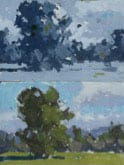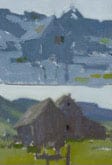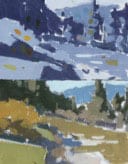Solvent Free Gel by Gamblin Artist Colors is one of my very favorite things. It is odorless, CLEAR, and thick enough to hold a good heavy paint stroke. It loads well on the brush and I love the way the paint feels when I lay it on the canvas. It is particularly great when using brushes that can support a lot of paint, like extra-long filberts. I began using it while painting in Plein air events to speed the drying time of my paint. Soon I was hooked and use it in my studio work now as well.

www.loriputnam.com
Oil Painting
The Pace Race
Like any vital, living thing, the art world is ever evolving. In the distant past, paintings were accomplished in the studio by painstaking application of layers of paint over a period of sometimes years. In the not-so-distant past, the trend toward alla prima painting increased the expectation of completing a piece in a much shorter time span. In the present day, time-lapse videography has made it possible to witness a 3-hour painting demonstration in eight or ten minutes! Now, there’s a wicked thing in my head that tells me I’m incompetent if I can’t paint a decent demo in eight or ten minutes. Not literally but, well, almost literally. The truth is, I’m a slow painter. I want to be a fast painter and this has steadily stolen my focus away from the simple joy of painting. This year I learned that I’m not alone; there’s a bunch of us trying to get faster. It’s a painters’ version of anorexia: you see the magazine cover of the perfect quick-draw painting and look at yourself to see if you’re good enough. You’re not good enough in your eyes so you start starving yourself and exercising and self-destructing, when all along you really were good enough; you were just different! Maybe you need someone to tell you that. Maybe I do, too.
At the end of last year, I decided that I wasn’t fast enough to be good enough to call myself a plein air painter. I set my goals for this year, and my Number One Goal was to learn to be a really fast landscape painter. My training heretofore was exclusively studio and mostly portrait-oriented, and while I’d been painting outdoors for more than a decade (and frankly loving it with an unadulterated love), I’d never actually been taught how to paint en plein air. My plein air works were, in the words of Robert Genn, “unabashed two-steppers.” I would paint as much as I could on site and then finish the rest later, using my mixes, my start, and my reference photos. I hadn’t entered any plein air events because of that, and I have felt more and more ashamed about it. Well, that was all about to change because I signed up for two workshops at the beginning of this year; one with Ray Roberts and the other with Jill Carver.
Both of these great artists and great teachers asked their students what they hoped to gain from the respective workshops and the answers were pretty much the same: we all wanted to learn to think and paint faster in the field: to come to a place and be able to compose a finished painting in our head while we were setting up, mentally Photoshop trees and rocks and rivers in and out and all around a canvas, capture the essence of it before the light changed, be able then to slap a frame on it and win a gold medal. That’s what we all hoped to learn.
Here’s what we all did learn: sometimes what you think you need to learn is different from what you actually need to learn. The gentle admonition from them was, it’s not about speed: that’s asking the wrong question. Jill suggested that there would never be an entry in an art book saying, “Painted between 2:00 and 3:45 p.m., whilst competing against so-and-so.” No, the painting must forever speak for itself and if you can’t paint it well going super fast, slow down. Neither of these painters comes to a landscape with an expectation of coming away with some kind of slap-dash masterpiece. Roberts’ approach was to consider plein air work as fact-finding and idea-catching, making numerous small sketches with an eye toward a studio piece. And Carver’s strategy was to make it less of a hunting expedition (her words) in which you “bag a prize,” and more of a private conversation with a friend. Her approach was very slow and polite; sketching ideas in a book with a sharpie and making notes before her kit was ever unpacked for painting. When she does get her gear out, she often divides up the canvas into two or four sections upon which to paint her response to the landscape. I’ll tell you how this affected me: I felt liberated. Liberated from my own expectations and free to be myself out there.
When I watch great painters paint, they do not ever seem to be in a hurry. Even if they accomplish a painting in a short time-span, they are very deliberate in their application. I felt all warm and tingly when I learned that my hero, John Singer Sargent, might paint and scrape a head sixteen times, so as to ultimately leave a fresh mark that seemed quick and effortless. But even before that, he’d done dozens of sketches. Seeing the plein air studies of another hero, Joaquin Sorolla, was exciting because they were all so tiny and jotty, like the shorthand notes of a writer! When I shared with my husband my new goal to be a fast painter, he said, “You don’t do anything fast! Why would you want to do the thing you love the most fast?” None of these things will sink very far into a hard head.
When Jill Carver paints a place, she has first loved it. Her painting is a poem about it. She has already sketched different versions of it and maybe painted several studies before she approaches the Painting Proper. When she set up for one demo, she situated her canvas so that her back was toward the subject. By doing this, she could only paint whatever she remembered once she was facing the canvas. This is an old Robert Henri trick. It requires a bit of your soul. But it takes a little longer.
Here are some studies done by Jill, exploring the number of values needed to convey a scene, preferring to keep it between three and five. This is one of the ways she helps her students to deconstruct and tune into the scene. Note the way she matches the colors to the values:
While we were working outside, her repeated, disarmingly funny, admonition was, “Paint what you see and keep it simple: after all, this is not rocket surgery.” She encouraged her students to relax and let the scene choose us, let it reveal itself to us; that requires calm and quietude. It is much more courteous and respectful than the smash-and-grab technique that I thought I wanted to learn.
Ray Roberts was working with rapidly changing light because, as luck would have it, we had rare weather blowing through the desert while we were out there, including riotous thunder storms! It was exhilarating to watch him work; he engaged the constantly changing light by constantly changing canvases! I know I would have decided to stay in the studio if the weather were unpredictable like that, but he taught us to move with the weather, to let it speak to us and take dictation so we could report our experience later. Our steno pad was the canvas, 8×10’s quartered, so that we could make four 4×5 inch paintings of the changing light. If he ran out of spaces, he tossed one canvas panel to the ground and picked up another, never chasing the light in one piece, but letting every change have its own space to speak. And again, he wasn’t slapping on the paint at 90 miles an hour; he was brief and deliberate, making exact notes that would bring a flood of memories back in the studio. His experience in the field was respectful and joyous, and that was conveyed in both the sketches and in the studio painting he did from them.
Here are some of the field studies done by Ray, and the studio painting that sprang from them:
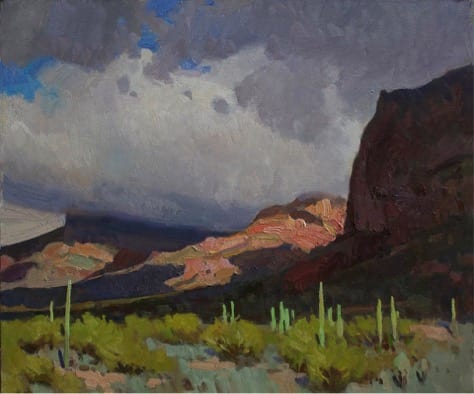
Notice how pieces of the studies found their way into the final painting, which truly captured the spirit of the experience, even though that single scene only existed in his mind’s eye.
Having been a runner, I know that there are some people who are good long-distance marathon runners, and others who are good short-distance sprinters; there are very few people who are good at both. There are master artists who enjoy the quiet, drawn-out pace of a marathon painting, working weeks or months (or years!) on a single piece, but who could not do a one-hour demo in front of an audience to save their own life. Then there are master artists who absolutely love the adrenaline-fueled fast pace of the quick-draw events and are astonishing in their ability to nail a sketch in one or two hours, but who could not spend any more time than that without going stir-crazy, and would never re-enter a painting that’s been “finished.” But! Sprinters do run long-distances when they are in training, and distance runners do train by running sprints for the same reason: it makes them better at what they’re good at.
So there are sprinter-painters who start out with a bang and run full-tilt to the tape, and there are marathon-painters, who have a relaxed stride and who pace themselves to endure a long run. But here’s the thing: painting is not a performance art. Jill’s right: the thing that will outlast us is the body of work we leave here. Focusing on speed, even if I secretly still want to paint fast, is focusing on the wrong thing. Use speed-painting as an exercise, not as a standard of excellence. Paint a lot! Remember, a million miles of canvas is one of the things it takes to make a great painter. And the more a person paints, the better a person learns to say more with less. It will happen at some point that it will take less time to do that well.
Ray Roberts and Jill Carver are able to produce masterpieces in the studio that are gleaned from their work in the field. They are also able to produce truly inspired pieces in the field because they are out there working in all weather, day in and day out: they are good because they train and hone their gift.
So now that the Year of Painting Fast is half over, I’m reassessing. Sometimes a person has to readjust their goals in order to be true to their purpose. My real purpose is to be the best artist I can be, and maybe I, personally, can’t do that by painting fast. We who call ourselves artists have chosen to run a road that is not easy, but we love it and that’s why we’re here. Applaud the sprinters, cheer the marathon runners, and enjoy your own journey. Press in happily and hard to the thing that makes your heart skip and sing when you paint. There are a lot of things going on out there but we really don’t have to do them all; we’re not failures if we don’t do them all. We need to just do our best thing in the very best way we can. Getting to do what you love is such a rare thing. We shouldn’t ruin it by wishing we could do something else. I think the thing I was starting to lose in my quest for quickness was the experience of just enjoying spending that time doing what I Iove to do! That old adage, “haste makes waste,” is an old adage for a good reason: it’s true! Haste could waste the thing that made you start on this road to begin with: the joy of painting.
So I’m adjusting my sights for the second half of this year: the point is the product, not the pace; this is not a race! I’m going to write a card to stick to my Soltek: “Haste Makes Waste~ Embrace Your Pace.” Even if I still feel the need for speed!
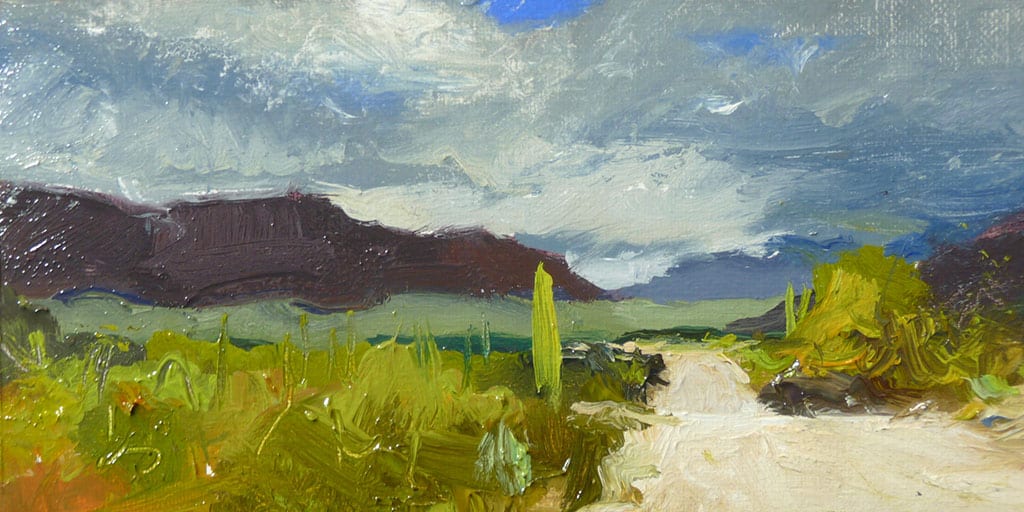
7×11
“Painted Between 2 & 3:45 Whilst Competing Against Kim Carlton”
Painting the Perfect Subject
Is there such a thing—the “perfect” subject to paint– on any given day?
Like song-choice for a musician, the subject an artist chooses to paint carries his/her personality, abilities and message to the viewers who will see it. Possibilities abound: perhaps a 300-foot tumbling waterfall, the sun poised on a dramatic orange horizon, or that striking profile of a most beautiful model. What really makes for a “perfect” subject?

Let’s see what some other artists say on that “subject:”
“The subject itself is no account; what matters is the way it is presented.” (Raoul Dufy)
“Content is more than ‘subject matter.’ It is all the feelings and ideas you bring to your painting.” (Rene Huyghe)
“There has to be that magical ‘urge’ and excitement to paint the subject, or it just will not work.” (Randall Sexton)
“Just because it is there, doesn’t mean you have to paint it.” (CJ Rider)
Is there such a thing—the “perfect” subject to paint– on any given day?

When choosing what to do next in their college courses, or in their personal lives, or in their careers, I have told my daughters, “choose to W.I.N.” Ask yourselves, “What’s Important Now?” –then do that. That is an aid to stay focused, look at the Big Picture, and avoid getting frustrated or sidelined by details.


“It is only with the heart that one can see rightly.” – Antoine de Sainte-Exupery
My Favorite Thing – Thomas Jefferson Kitts
The Ubiquitous All-purpose Palette Knife
 When I first saw this palette knife in the hands of Richard Schmid a lightbulb went off. Years later, I have found this knife to be the most useful tool ever. I can rapidly mix my colors and paint with it, and it is substantial enough to scrape a wet or dry passage of paint down to the underlying ground. I prefer this knife because the blade is metal, wedge-shaped, and has an ‘off-set’ handle. The blade itself is about 1 inch wide at the base and about 3 inches in length. The width allows me to mix a lot of color quickly and the tip makes short work of applying a highlight. The length allows me to laid down an incredibly sharp line or crisp edge on the rare occasion I need one, far thinner than any rigger can create. I use this knife to mix my neutral light tints, such as flesh and snow, which keeps those delicate colors clean, and I use it to scrape off the inevitable failure when they occur. And yes, I abuse this knife constantly. I drop it often and clean my palette with it at the end of the day. (Or a week later, to admit the truth…ha!) And yes, the offset handle keeps my knuckles out of the paint – a constant hazard for me. These knives are so cheap I give them away in my workshops.
When I first saw this palette knife in the hands of Richard Schmid a lightbulb went off. Years later, I have found this knife to be the most useful tool ever. I can rapidly mix my colors and paint with it, and it is substantial enough to scrape a wet or dry passage of paint down to the underlying ground. I prefer this knife because the blade is metal, wedge-shaped, and has an ‘off-set’ handle. The blade itself is about 1 inch wide at the base and about 3 inches in length. The width allows me to mix a lot of color quickly and the tip makes short work of applying a highlight. The length allows me to laid down an incredibly sharp line or crisp edge on the rare occasion I need one, far thinner than any rigger can create. I use this knife to mix my neutral light tints, such as flesh and snow, which keeps those delicate colors clean, and I use it to scrape off the inevitable failure when they occur. And yes, I abuse this knife constantly. I drop it often and clean my palette with it at the end of the day. (Or a week later, to admit the truth…ha!) And yes, the offset handle keeps my knuckles out of the paint – a constant hazard for me. These knives are so cheap I give them away in my workshops.
I have even sharpened the edge of the blade like a chisel, to give it the ability to cut through a crusty paint film without digging into the ground below. You can read about it here
www.thomaskitts.com
WHAT DO YOU DO? “I AM AN ARTIST.”
How far into your artist career did you start answering to the ever-present question, “What do you do?” with a smile and an assertive reply “I AM AN ARTIST”? This is a query I presented to all my mentors at the beginning of my artistic career some years ago after switching from Petroleum Engineering and International business fields.
I would like to revisit this question once more on behalf of all those people out there considering changing paths in life and crossing the bridge to becoming full-time artists. To the question above, some artists said they always responded with “I AM AN ARTIST” but most replied that they avoided the question, sidetracked it, redirected it or simply ignored it to avoid the obnoxious looks from friends and family expecting them to have grown up and taken a “serious track.” In the words of the artist Ben Shahn, “I believe that if it were left to artists to choose their own labels most would choose none.”
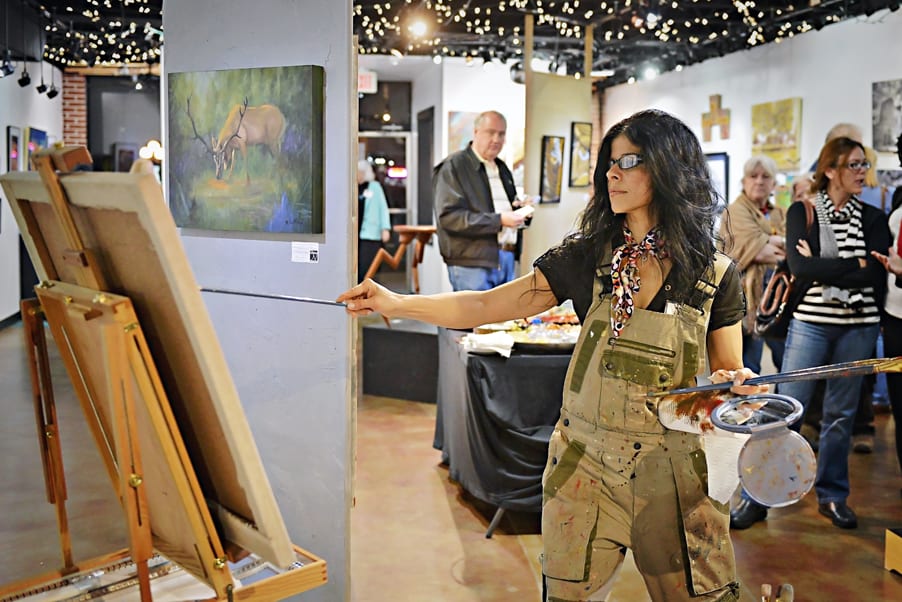
Is an art career even worth pursuing? After all, only the most determined artists can sustain themselves with art-related income. Isn’t it true that many artists have been ignored all their lives only to be recognized for their vision, genius and creativity until much later after their deaths? We admire and revere the works of artists such as Brunelleschi, DaVinci, Caravaggio, Van Gogh, Modigliani, Vermeer, El Greco, Rembrandt, Gaugin and other artistic geniuses. Weren’t they for many years the outcasts or had careers marred by debt. Some, nobody knew about until their works were found in dark monasteries, forgotten and uncared for, then studied, revived and given the value they deserved, decades or even centuries after the artists were deceased?
“Starving Artist” is a cliché that has been casted by well-intentioned people to deter us from being successful and happy. Art is, in my opinion, a very rewarding career, but it is not an easy tag to put on your head and display proudly to those close to you. Art in our society tends to be perceived as the choice of irresponsible, unreliable people and that of dreamers. Family pressure to stir you out of your path is often very painful and difficult to overcome.
Of all those artist-to-be, some who are strong and stubborn enough will pursue an art degree even at the cost of their family disapproval. Others, like myself, will take up a different career altogether, following the advice of elders and peers. Those who persisted and managed to go to art school enjoy tremendously the learning process and the exhilarating sense of creating out of simple thoughts what they perceive as a reality. However when school was over, and there were no projects to submit, no classes to attend, no teachers to please and no peers to offer support, many art graduates found the irreconcilable truth that their creativity was drained and creating was now a painful process. Many went into other fields just to avoid the risk of displeasing the world. Many denied they were artists choosing to wear a different hat and label.
On the other hand, those of us for whom the influence of our peers, siblings, parents, teachers, guides succeeded in rerouting our destiny, go through life carrying with ourselves mixed feelings of guilt, remorse, regret and a sense of an unlived life, questioning who we are and what we are supposed to become, where and why we strayed. In both cases, it is only by the tenacious and persistent tug of your “true call” that a trained but forgotten artist in the first scenario or the hidden artist in the second, becomes a real artist.
Many people in the engineering, medical, science fields are returning home to what they feel is their true path: doing art. Workshops, ateliers, art schools, continuing education classes are full of those lost artists, talented, determined, ready to shake the shame off and create. I did it several years ago, transferring from petroleum engineering to art, without any previous knowledge or experience and not knowing where to start, but being blindly guided by an intense desire to do what I came here to do. I applaud those people, who like me years ago, are jumping in now, because giving up a financially prosperous career, steady income, promotions, benefits, stability, in lieu of a profession where nothing is certain, requires a monumental leap of faith and an unfathomable amount of perseverance and courage.
I can assure you, having been through it, that once on the other side, you will never regret it. The happiness of living your true call is absolutely priceless, especially when you can experience the most exhilarating moments immersed in your own creations and the immense possibilities that your mind will open to you in a creative career such as in the arts.
The transition cannot be left unplanned though. There are several strategies that you can use to make the leap less strenuous. I am listing below the ABC’s that personally helped me with a swift and smooth shift.
- Art books and guidance books such as Art and Fear by David Bayles and Ted Orland, The Artist Way by Julia Cameron and Accelerating on the Curves by Katharine T. Carter will boost your creativity and will help you find the courage and confidence needed for the switch.
- Be prepared. Prepare a financial plan that allows you to leave your current job without monetary distress. Assessing your resources, expenses and savings will reduce the pressure of meeting financial obligations on top of the transition.
- Connect. Find a mentor, willing to support you from the beginning. Look for artists whose art you admire and enquiry on mentorships. Contact art communities, Art Leagues, and colleges where you can associate with other artists. These groups will motivate you, and encourage you to improve and grow.
- Develop your skills by doing art daily and by registering for classes, workshops at art schools, art organizations or individual teachers near you. On this topic, I’ve heard this wise quote from Bart Lindstrom, “Step one is to get really good. Step two is to get out there. The better you do step one, the easier step two is.”
- Establish realistic goals both short and long term. Knowing where you want to go will help you see the opportunities available to reach your set objectives.
If you are in the midst of making the decision of crossing the bridge, I would recommend you to go ahead and do it. Start by proudly calling yourself AN ARTIST!
In the words of Ralph Waldo Emerson “What lies behind us and what lies before us is tiny matters compared to what lies within us.
www.hruedart.com
